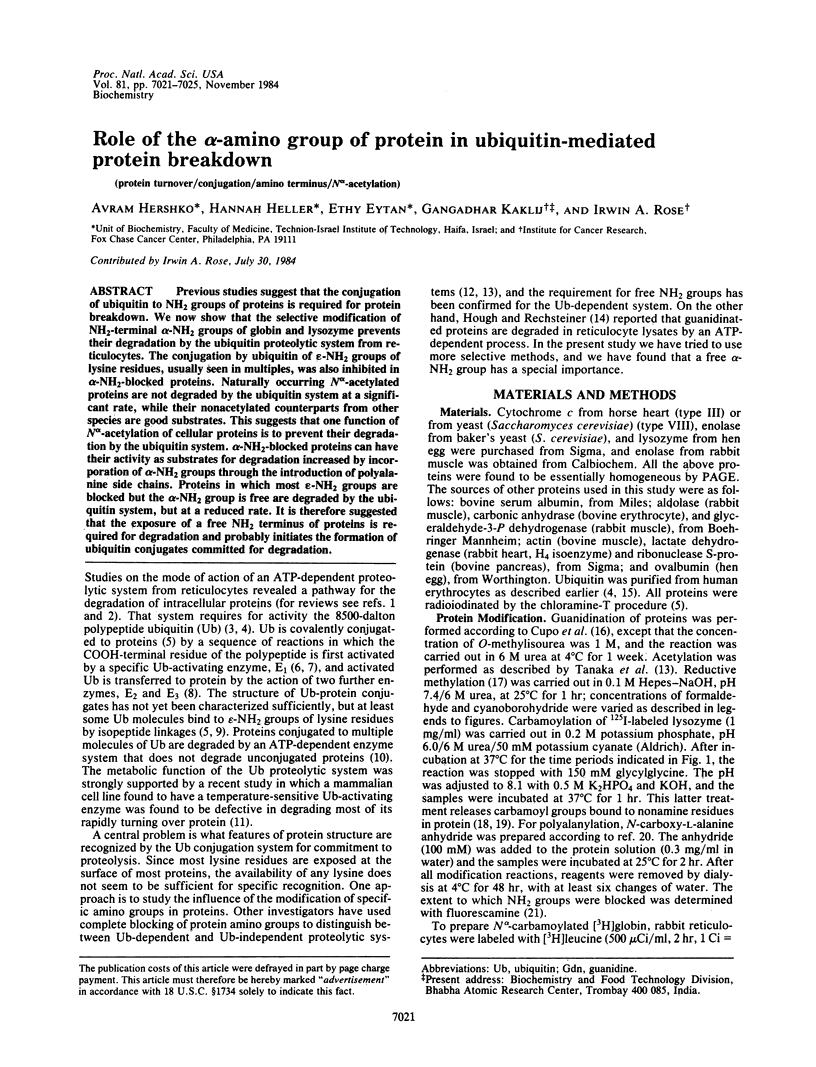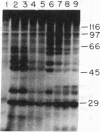Abstract
Previous studies suggest that the conjugation of ubiquitin to NH2 groups of proteins is required for protein breakdown. We now show that the selective modification of NH2-terminal alpha-NH2 groups of globin and lysozyme prevents their degradation by the ubiquitin proteolytic system from reticulocytes. The conjugation by ubiquitin of epsilon-NH2 groups of lysine residues, usually seen in multiples, was also inhibited in alpha-NH2-blocked proteins. Naturally occurring N alpha-acetylated proteins are not degraded by the ubiquitin system at a significant rate, while their nonacetylated counterparts from other species are good substrates. This suggests that one function of N alpha-acetylation of cellular proteins is to prevent their degradation by the ubiquitin system. alpha-NH2-blocked proteins can have their activity as substrates for degradation increased by incorporation of alpha-NH2 groups through the introduction of polyalanine side chains. Proteins in which most epsilon-NH2 groups are blocked but the alpha-NH2 group is free are degraded by the ubiquitin system, but at a reduced rate. It is therefore suggested that the exposure of a free NH2 terminus of proteins is required for degradation and probably initiates the formation of ubiquitin conjugates committed for degradation.
Full text
PDF




Images in this article
Selected References
These references are in PubMed. This may not be the complete list of references from this article.
- BECKER R. R., STAHMANN M. A. Protein modification by reaction with N-carboxyamino acid anhydrides. J Biol Chem. 1953 Oct;204(2):745–752. [PubMed] [Google Scholar]
- Brown J. L. A comparison of the turnover of alpha-N-acetylated and nonacetylated mouse L-cell proteins. J Biol Chem. 1979 Mar 10;254(5):1447–1449. [PubMed] [Google Scholar]
- Brown J. L., Roberts W. K. Evidence that approximately eighty per cent of the soluble proteins from Ehrlich ascites cells are Nalpha-acetylated. J Biol Chem. 1976 Feb 25;251(4):1009–1014. [PubMed] [Google Scholar]
- Böhlen P., Stein S., Dairman W., Udenfriend S. Fluorometric assay of proteins in the nanogram range. Arch Biochem Biophys. 1973 Mar;155(1):213–220. doi: 10.1016/s0003-9861(73)80023-2. [DOI] [PubMed] [Google Scholar]
- CHERVENKA C. H., WILCOX P. E. Chemical derivatives of chymotrypsinogen. II. Reaction with O-methylisourea. J Biol Chem. 1956 Oct;222(2):635–647. [PubMed] [Google Scholar]
- Cerami A., Manning J. M. Potassium cyanate as an inhibitor of the sickling of erythrocytes in vitro. Proc Natl Acad Sci U S A. 1971 Jun;68(6):1180–1183. doi: 10.1073/pnas.68.6.1180. [DOI] [PMC free article] [PubMed] [Google Scholar]
- Ciechanover A., Elias S., Heller H., Hershko A. "Covalent affinity" purification of ubiquitin-activating enzyme. J Biol Chem. 1982 Mar 10;257(5):2537–2542. [PubMed] [Google Scholar]
- Ciechanover A., Finley D., Varshavsky A. Ubiquitin dependence of selective protein degradation demonstrated in the mammalian cell cycle mutant ts85. Cell. 1984 May;37(1):57–66. doi: 10.1016/0092-8674(84)90300-3. [DOI] [PubMed] [Google Scholar]
- Ciehanover A., Hod Y., Hershko A. A heat-stable polypeptide component of an ATP-dependent proteolytic system from reticulocytes. Biochem Biophys Res Commun. 1978 Apr 28;81(4):1100–1105. doi: 10.1016/0006-291x(78)91249-4. [DOI] [PubMed] [Google Scholar]
- Cupo P., El-Deiry W., Whitney P. L., Awad W. M., Jr Stabilization of proteins by guanidination. J Biol Chem. 1980 Nov 25;255(22):10828–10833. [PubMed] [Google Scholar]
- Goldknopf I. L., Busch H. Isopeptide linkage between nonhistone and histone 2A polypeptides of chromosomal conjugate-protein A24. Proc Natl Acad Sci U S A. 1977 Mar;74(3):864–868. doi: 10.1073/pnas.74.3.864. [DOI] [PMC free article] [PubMed] [Google Scholar]
- Haas A. L., Warms J. V., Hershko A., Rose I. A. Ubiquitin-activating enzyme. Mechanism and role in protein-ubiquitin conjugation. J Biol Chem. 1982 Mar 10;257(5):2543–2548. [PubMed] [Google Scholar]
- Hendil K. B. Intracellular degradation of hemoglobin transferred into fibroblasts by fusion with red blood cells. J Cell Physiol. 1980 Dec;105(3):449–460. doi: 10.1002/jcp.1041050309. [DOI] [PubMed] [Google Scholar]
- Hershko A., Ciechanover A., Heller H., Haas A. L., Rose I. A. Proposed role of ATP in protein breakdown: conjugation of protein with multiple chains of the polypeptide of ATP-dependent proteolysis. Proc Natl Acad Sci U S A. 1980 Apr;77(4):1783–1786. doi: 10.1073/pnas.77.4.1783. [DOI] [PMC free article] [PubMed] [Google Scholar]
- Hershko A., Ciechanover A. Mechanisms of intracellular protein breakdown. Annu Rev Biochem. 1982;51:335–364. doi: 10.1146/annurev.bi.51.070182.002003. [DOI] [PubMed] [Google Scholar]
- Hershko A., Ciechanover A., Rose I. A. Identification of the active amino acid residue of the polypeptide of ATP-dependent protein breakdown. J Biol Chem. 1981 Feb 25;256(4):1525–1528. [PubMed] [Google Scholar]
- Hershko A., Heller H., Elias S., Ciechanover A. Components of ubiquitin-protein ligase system. Resolution, affinity purification, and role in protein breakdown. J Biol Chem. 1983 Jul 10;258(13):8206–8214. [PubMed] [Google Scholar]
- Hershko A., Leshinsky E., Ganoth D., Heller H. ATP-dependent degradation of ubiquitin-protein conjugates. Proc Natl Acad Sci U S A. 1984 Mar;81(6):1619–1623. doi: 10.1073/pnas.81.6.1619. [DOI] [PMC free article] [PubMed] [Google Scholar]
- Hershko A. Ubiquitin: roles in protein modification and breakdown. Cell. 1983 Aug;34(1):11–12. doi: 10.1016/0092-8674(83)90131-9. [DOI] [PubMed] [Google Scholar]
- Hough R., Rechsteiner M. Effects of temperature on the degradation of proteins in rabbit reticulocyte lysates and after injection into HeLa cells. Proc Natl Acad Sci U S A. 1984 Jan;81(1):90–94. doi: 10.1073/pnas.81.1.90. [DOI] [PMC free article] [PubMed] [Google Scholar]
- Jentoft N., Dearborn D. G. Labeling of proteins by reductive methylation using sodium cyanoborohydride. J Biol Chem. 1979 Jun 10;254(11):4359–4365. [PubMed] [Google Scholar]
- Jörnvall H. Acetylation of Protein N-terminal amino groups structural observations on alpha-amino acetylated proteins. J Theor Biol. 1975 Nov;55(1):1–12. doi: 10.1016/s0022-5193(75)80105-6. [DOI] [PubMed] [Google Scholar]
- Katznelson R., Kulka R. G. Degradation of microinjected methylated and unmethylated proteins in hepatoma tissue culture cells. J Biol Chem. 1983 Aug 25;258(16):9597–9600. [PubMed] [Google Scholar]
- Manning J. M., Lee C. K., Cerami A., Gillette P. N. Gas chromatographic determination of the carbamylation of hemoglobin S by cyanate. J Lab Clin Med. 1973 Jun;81(6):941–945. [PubMed] [Google Scholar]
- Manning J. M. Preparation of hemoglobin carbamylated at specific NH2-terminal residues. Methods Enzymol. 1981;76:159–167. doi: 10.1016/0076-6879(81)76124-x. [DOI] [PubMed] [Google Scholar]
- Stark G. R. Reactions of cyanate with functional groups of proteins. 3. Reactions with amino and carboxyl groups. Biochemistry. 1965 Jun;4(6):1030–1036. doi: 10.1021/bi00882a008. [DOI] [PubMed] [Google Scholar]
- Tanaka K., Waxman L., Goldberg A. L. ATP serves two distinct roles in protein degradation in reticulocytes, one requiring and one independent of ubiquitin. J Cell Biol. 1983 Jun;96(6):1580–1585. doi: 10.1083/jcb.96.6.1580. [DOI] [PMC free article] [PubMed] [Google Scholar]
- VELICK S. F. The metabolism of myosin, the meromyosins, actin and tropomyosin in the rabbit. Biochim Biophys Acta. 1956 Apr;20(1):228–236. doi: 10.1016/0006-3002(56)90281-5. [DOI] [PubMed] [Google Scholar]
- Wold F. In vivo chemical modification of proteins (post-translational modification). Annu Rev Biochem. 1981;50:783–814. doi: 10.1146/annurev.bi.50.070181.004031. [DOI] [PubMed] [Google Scholar]



